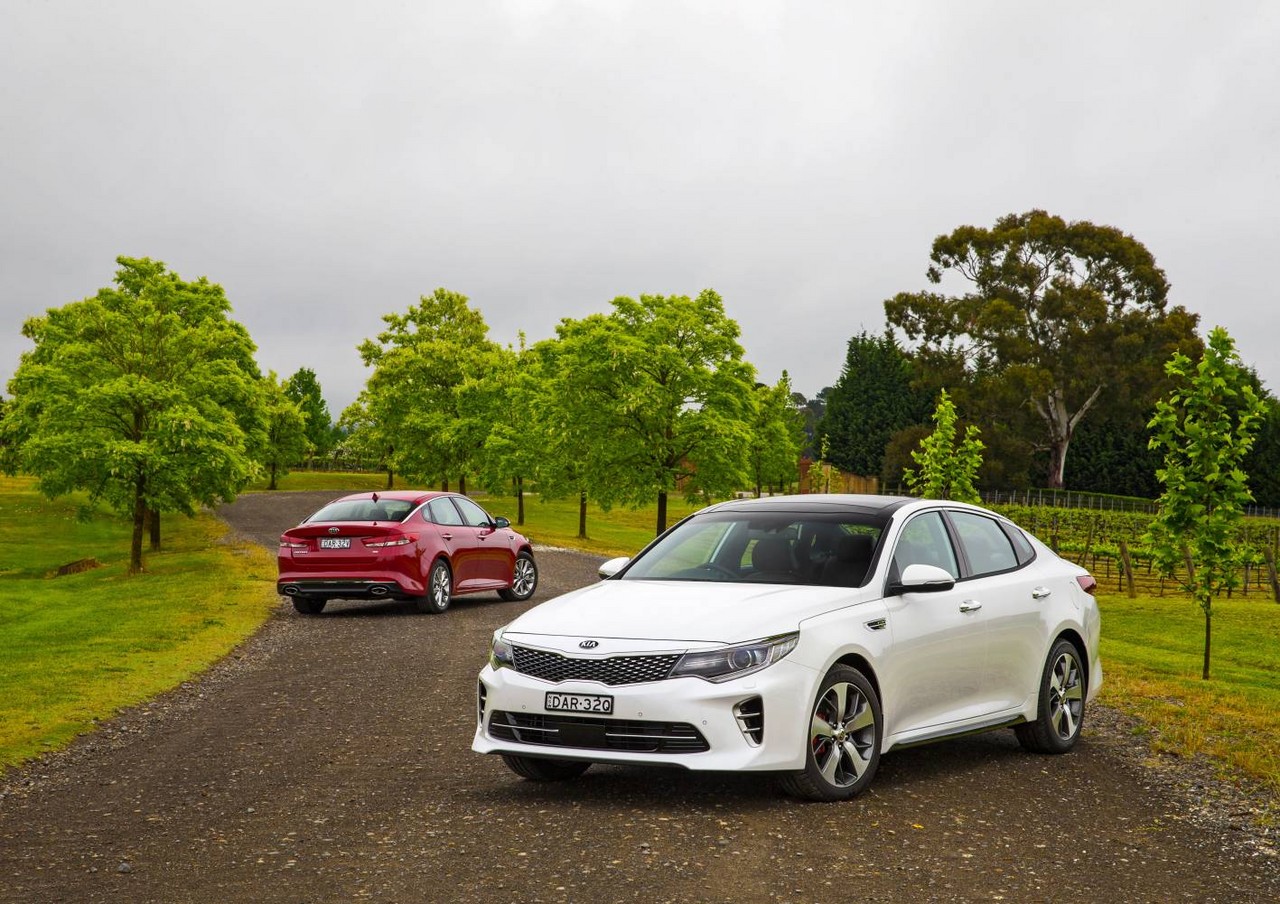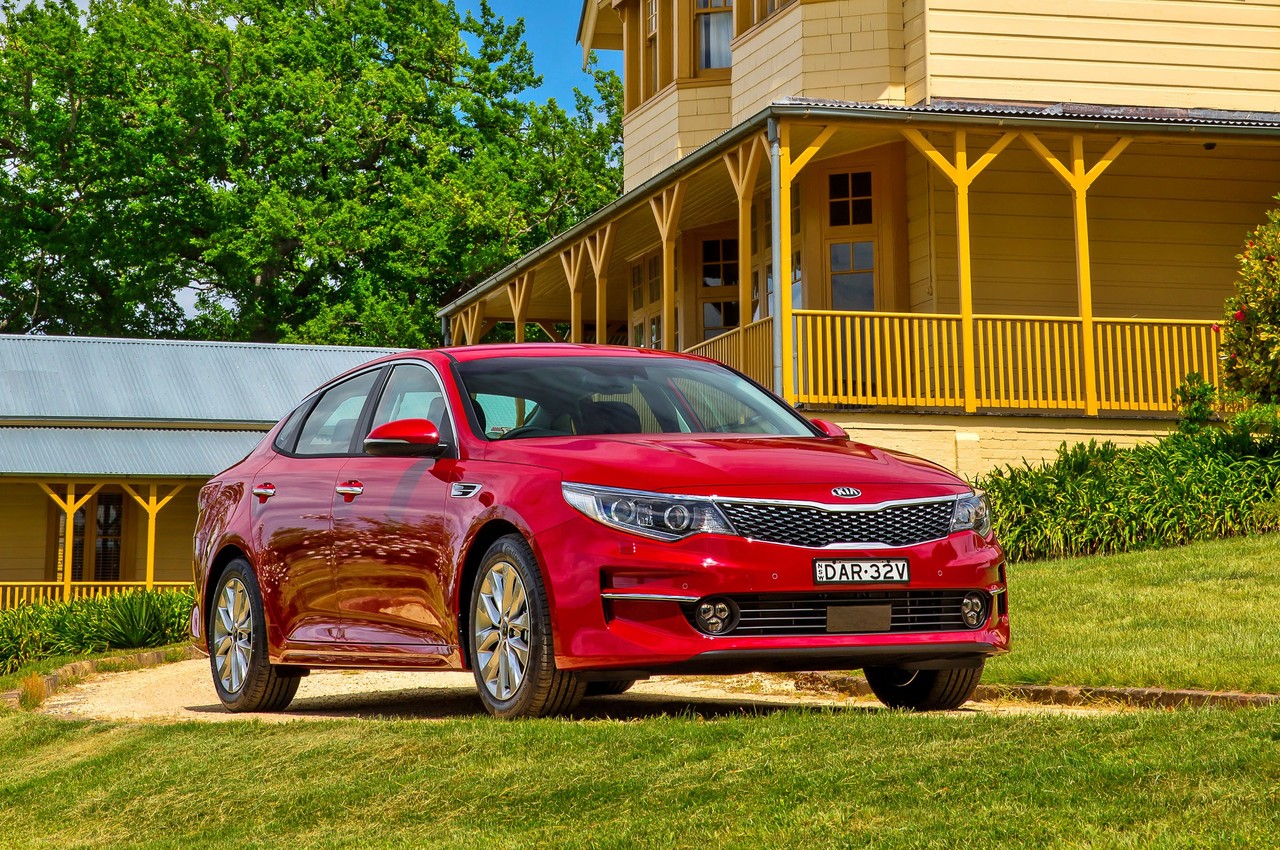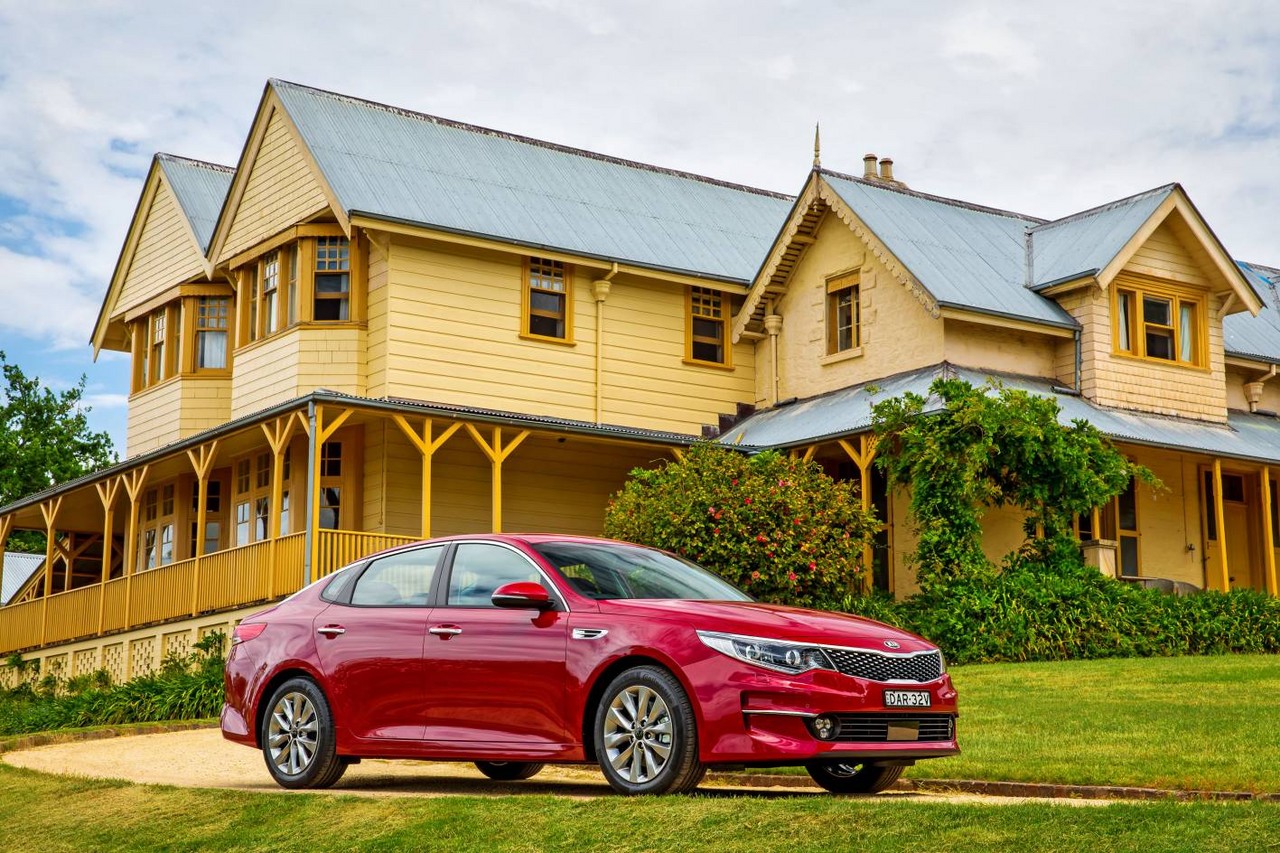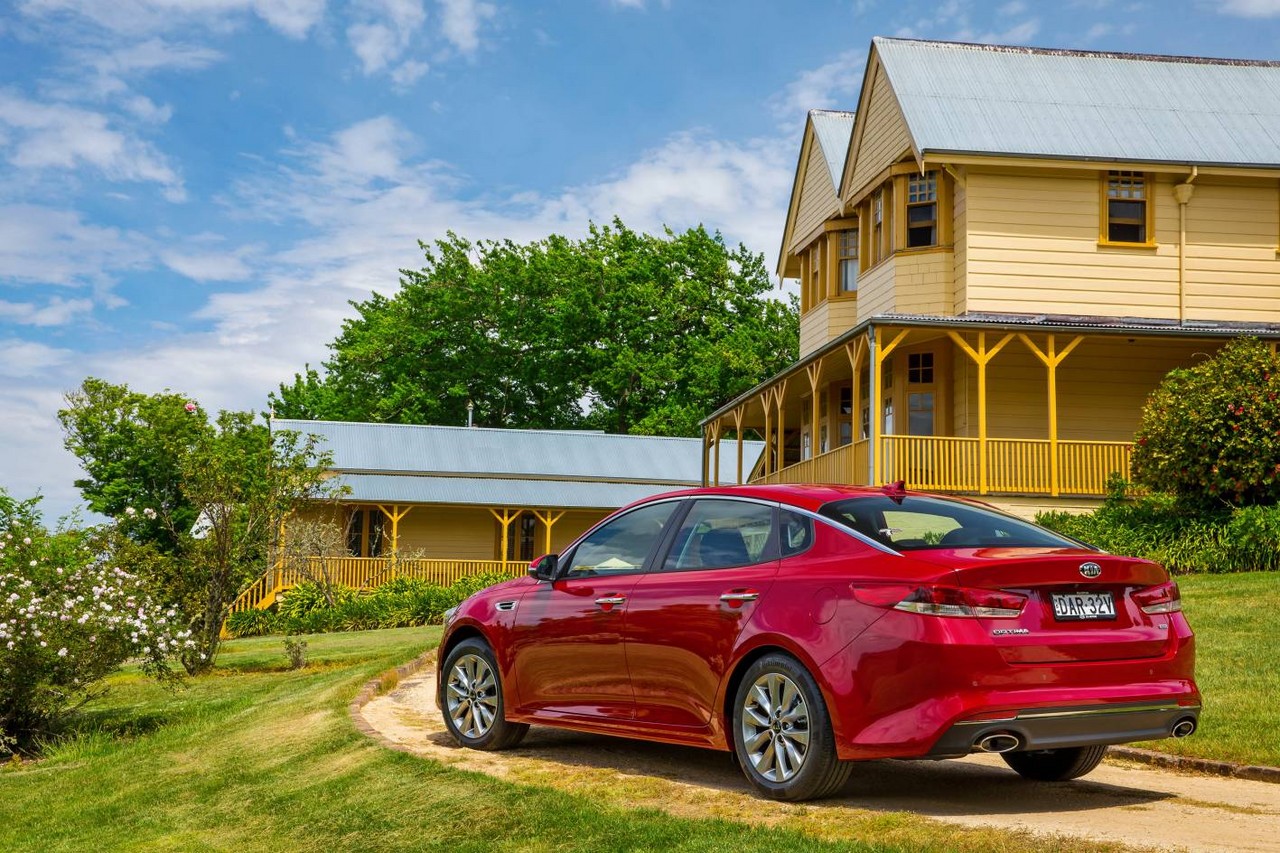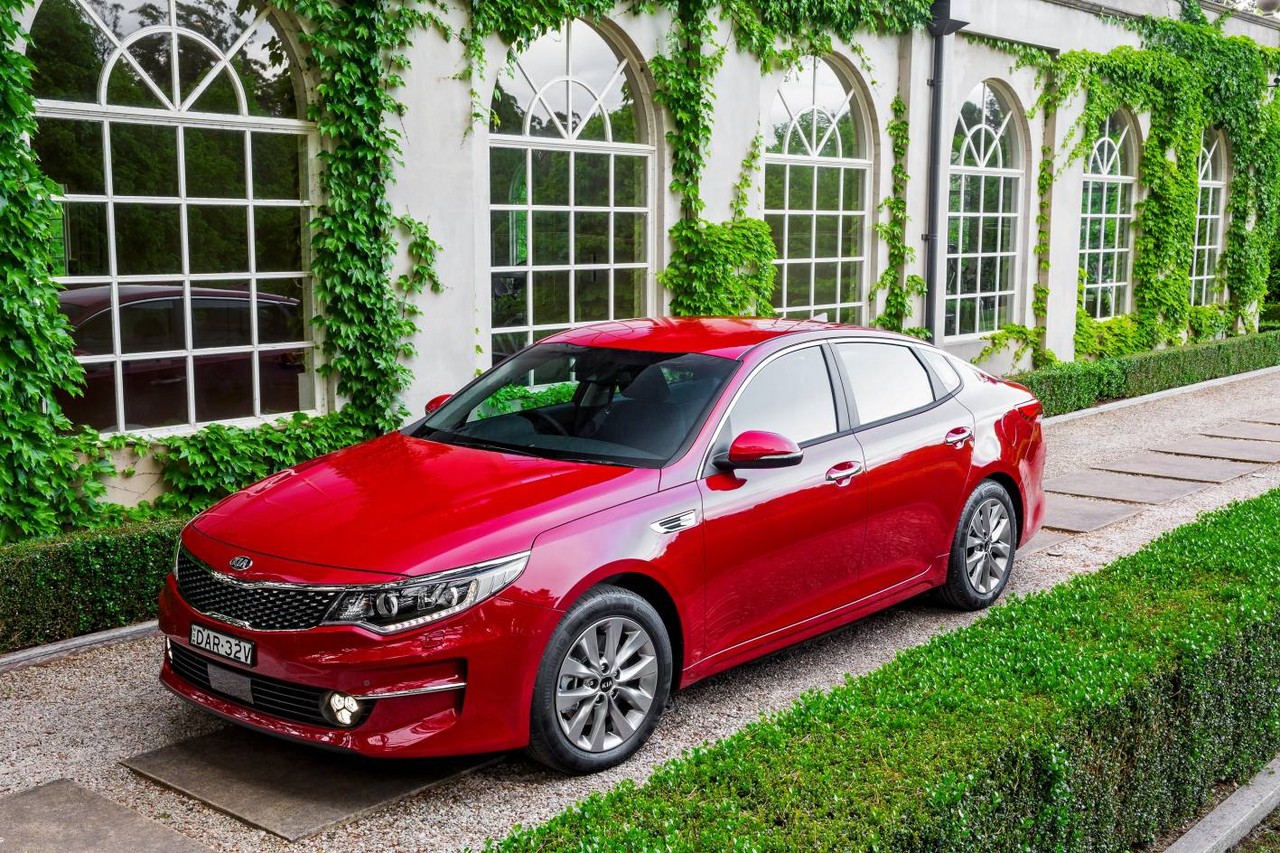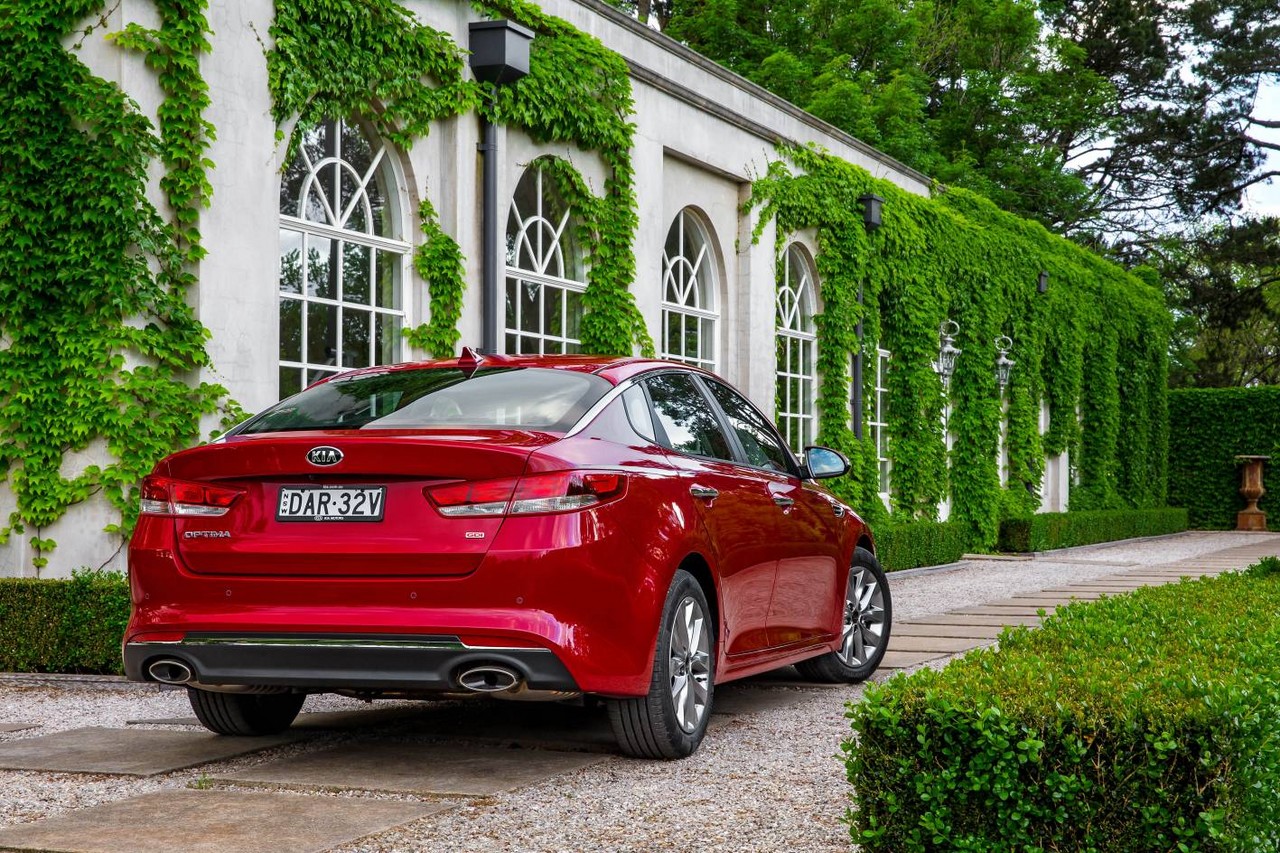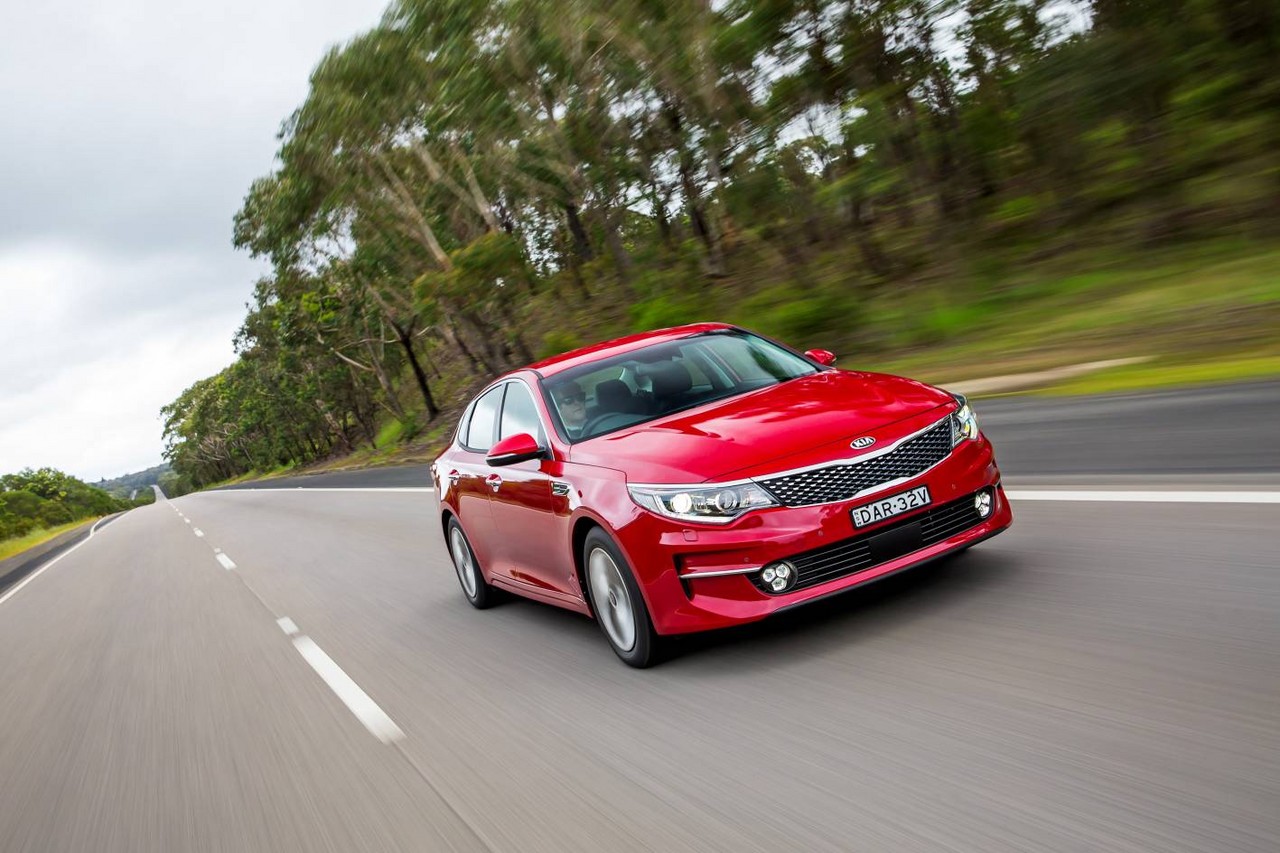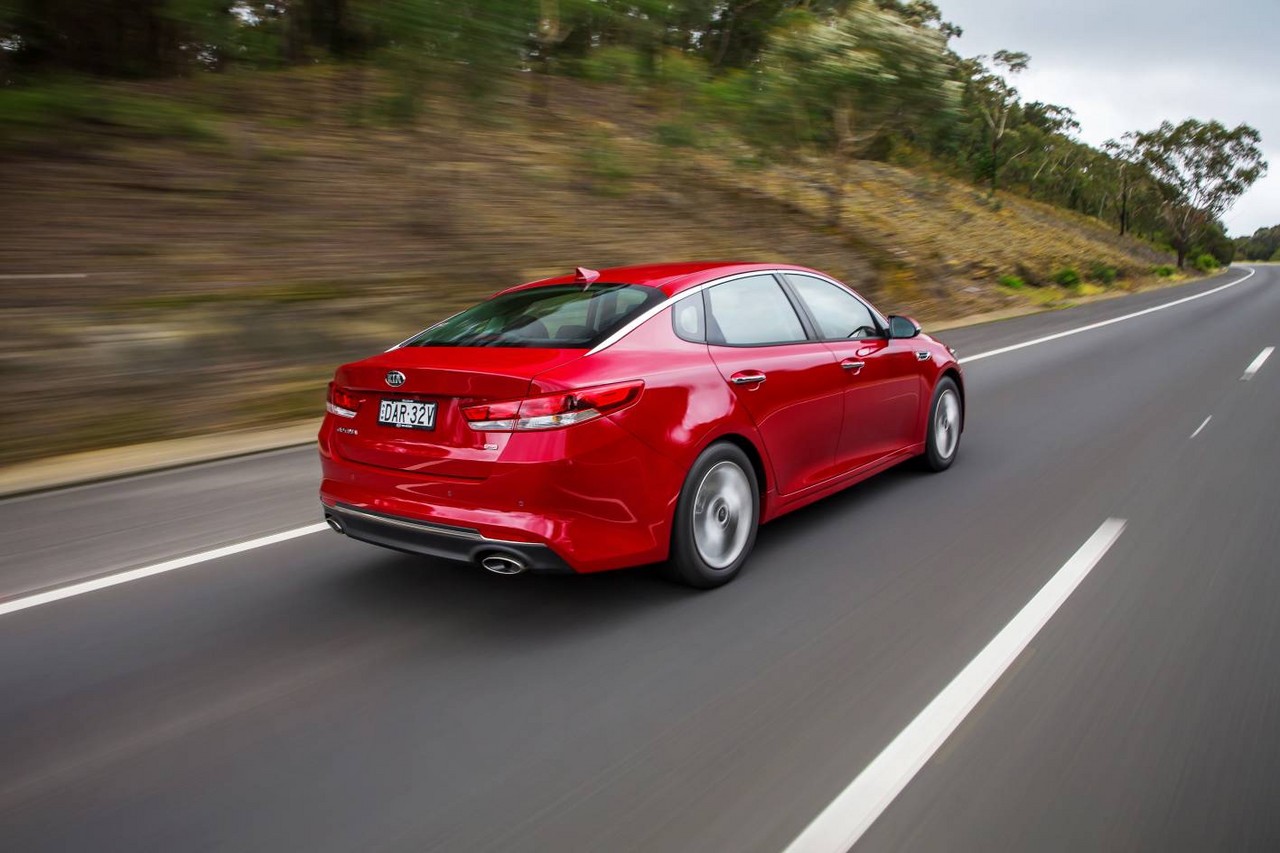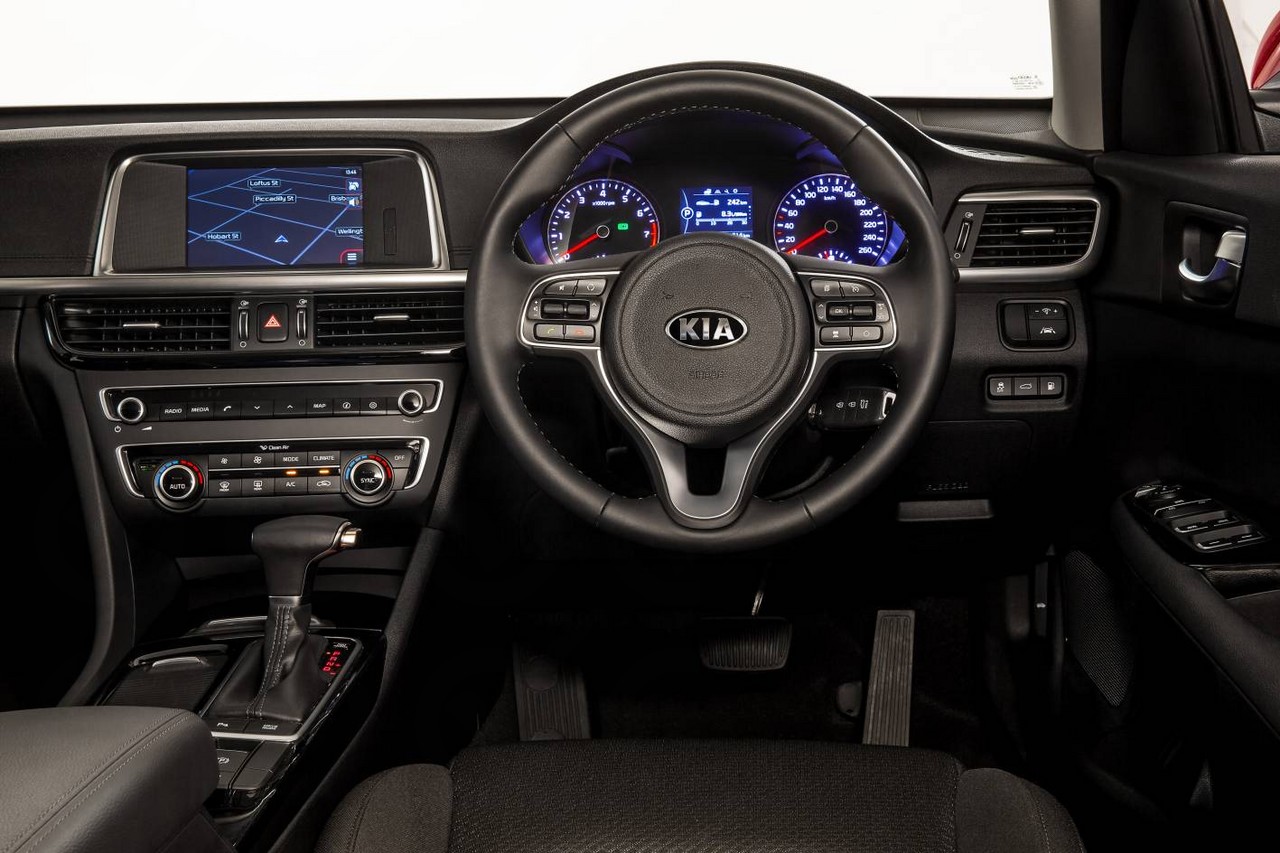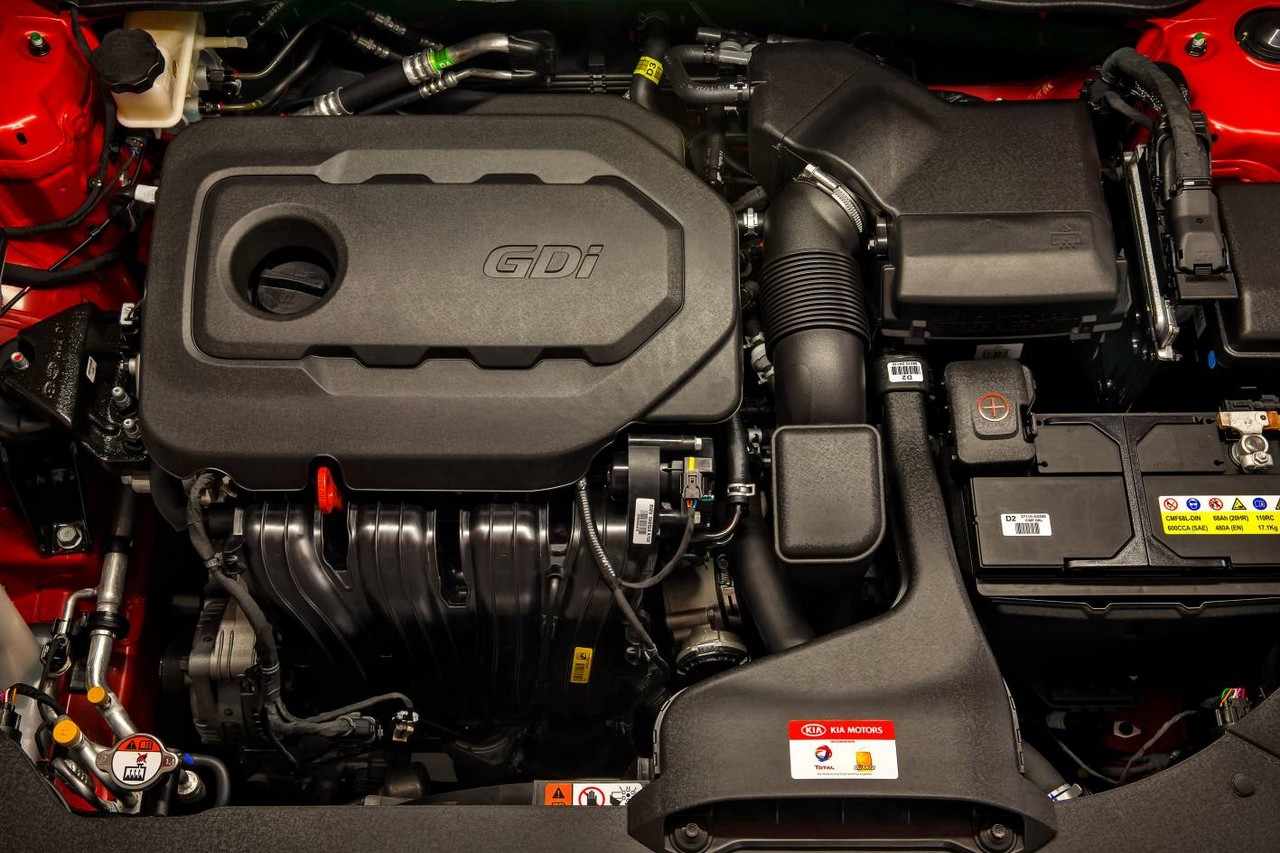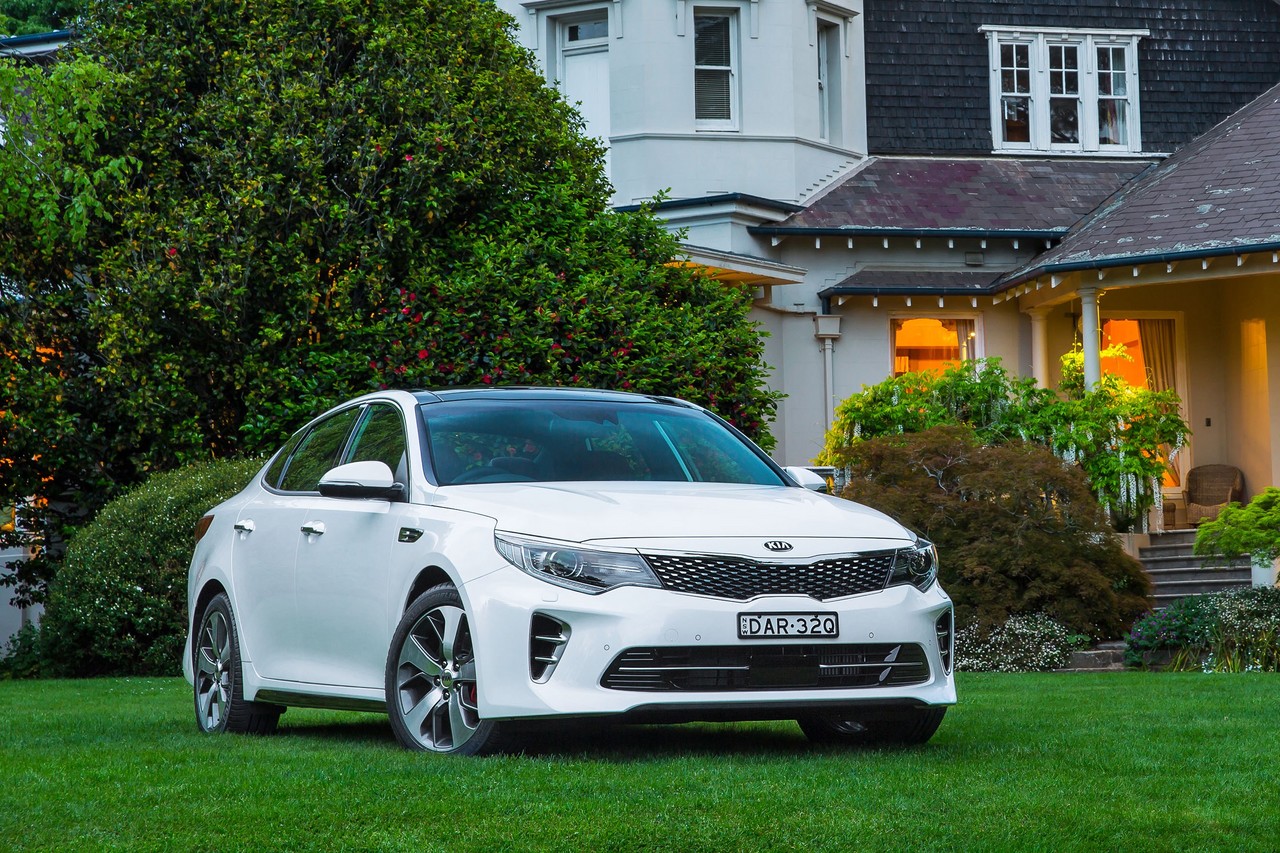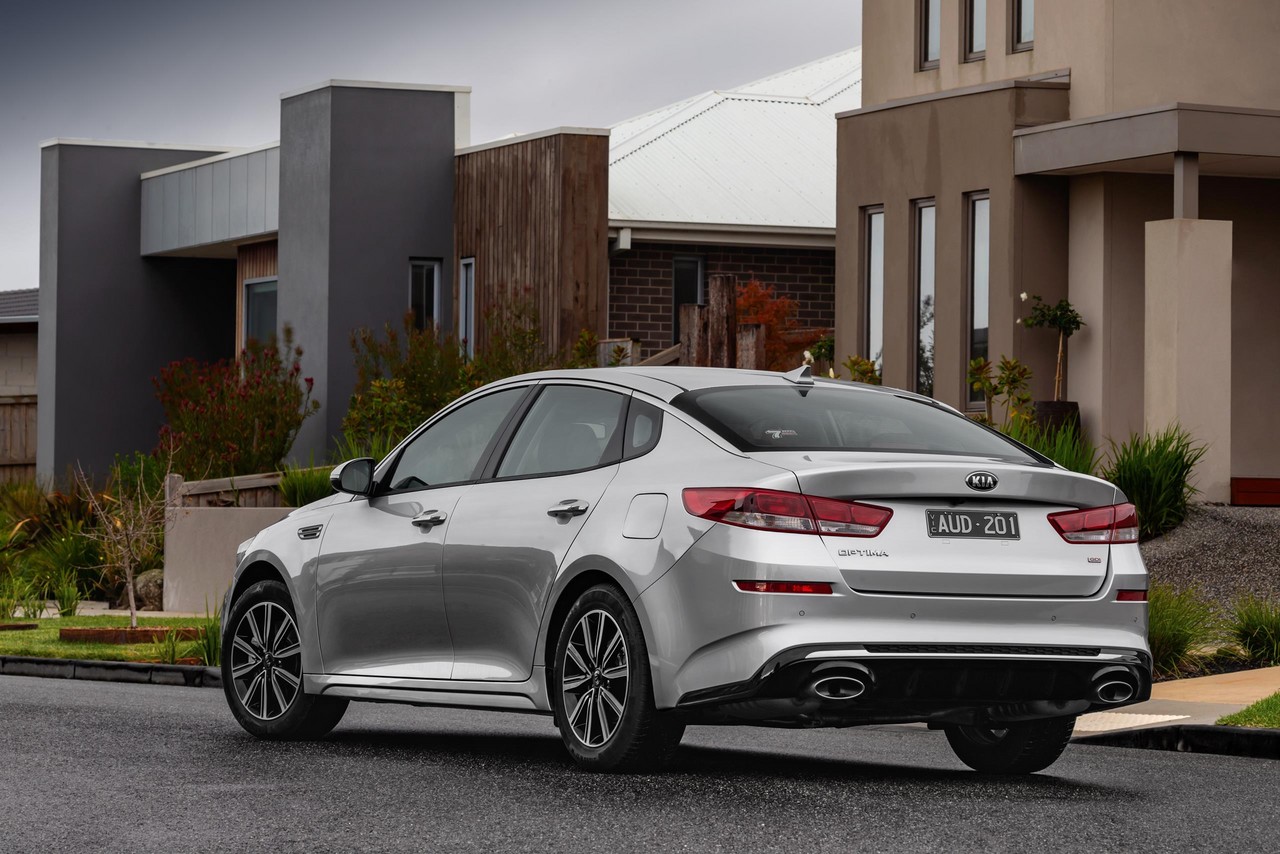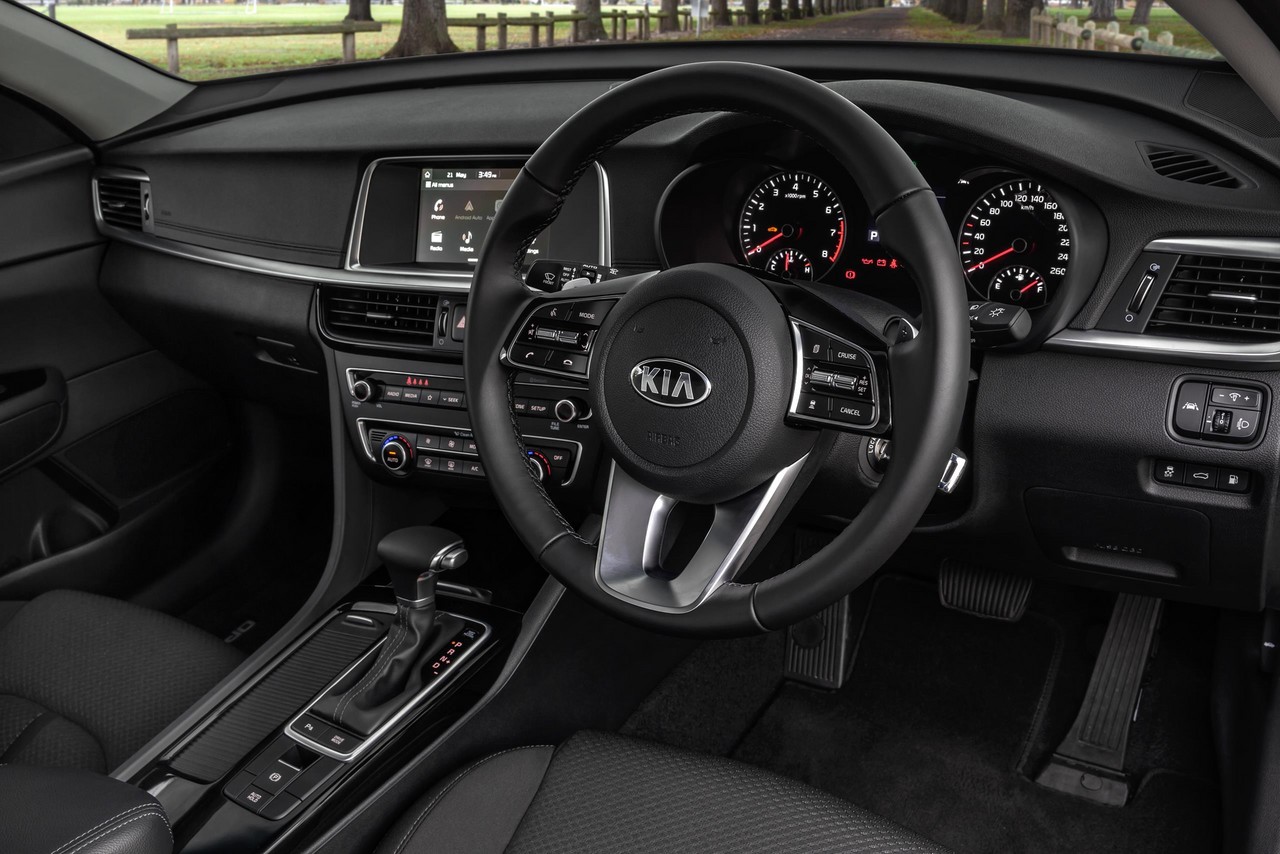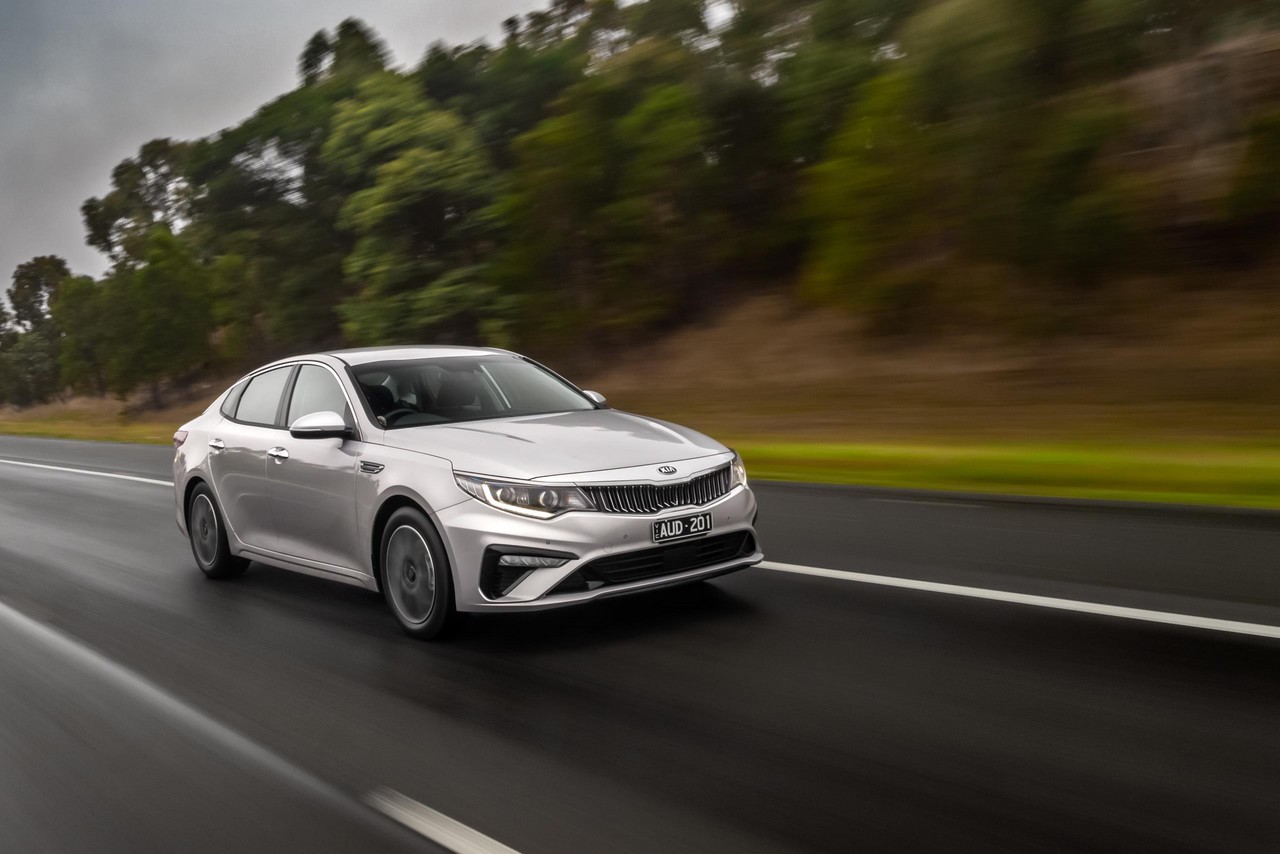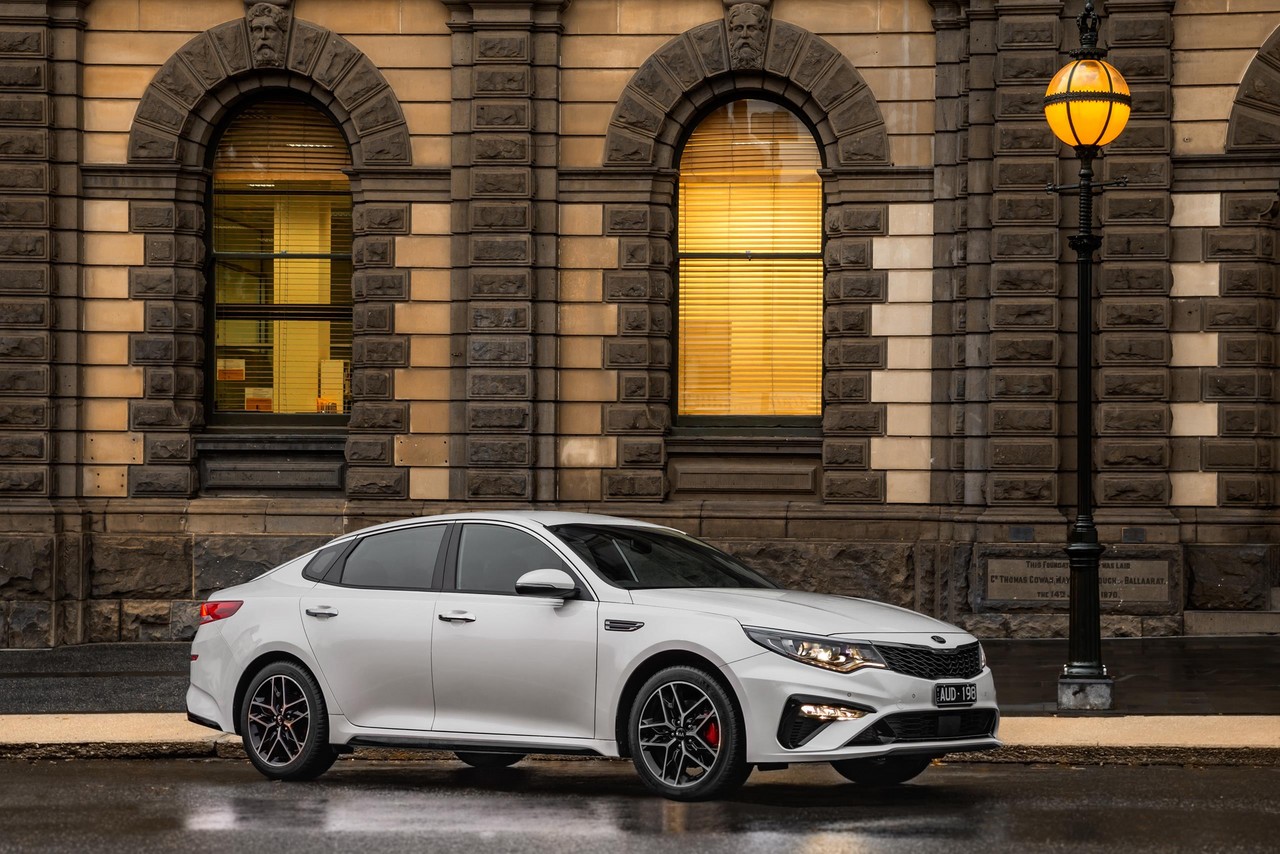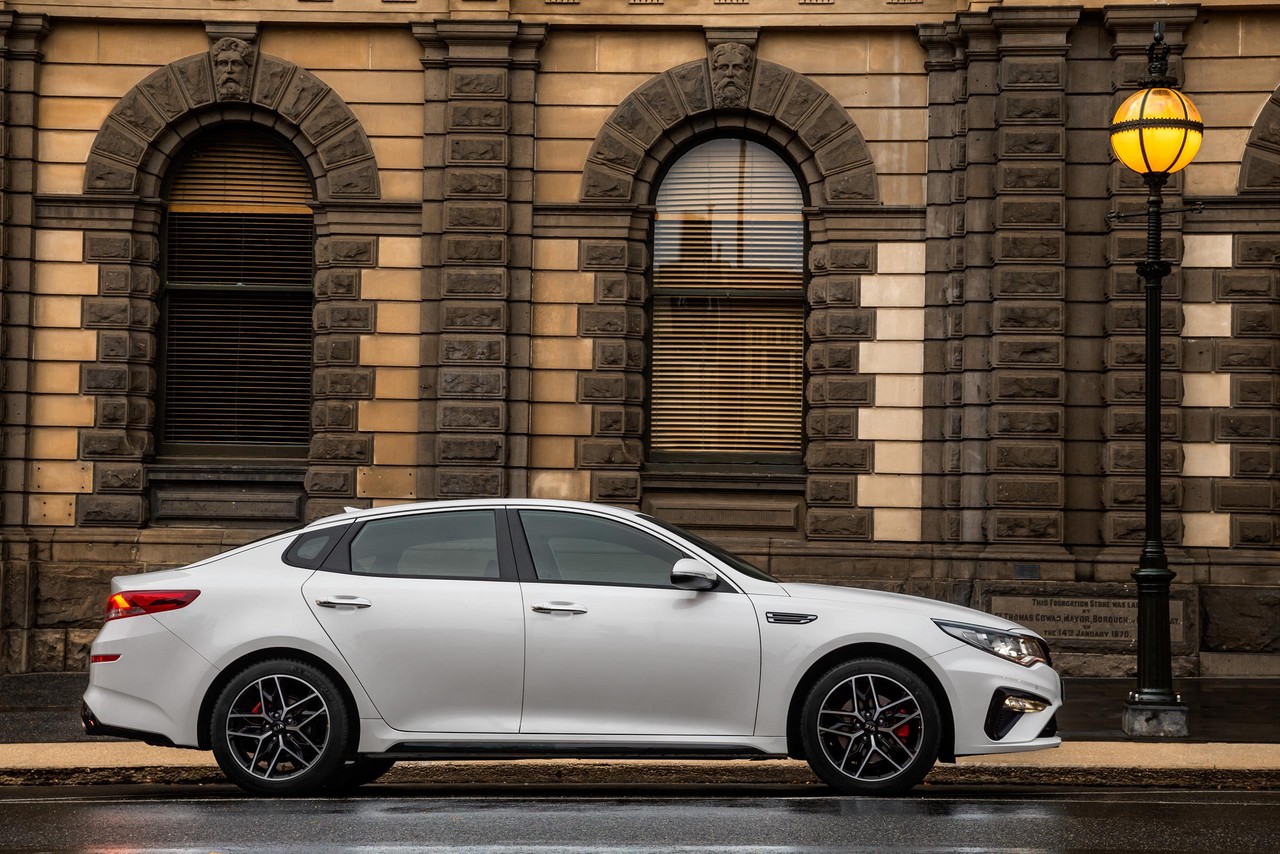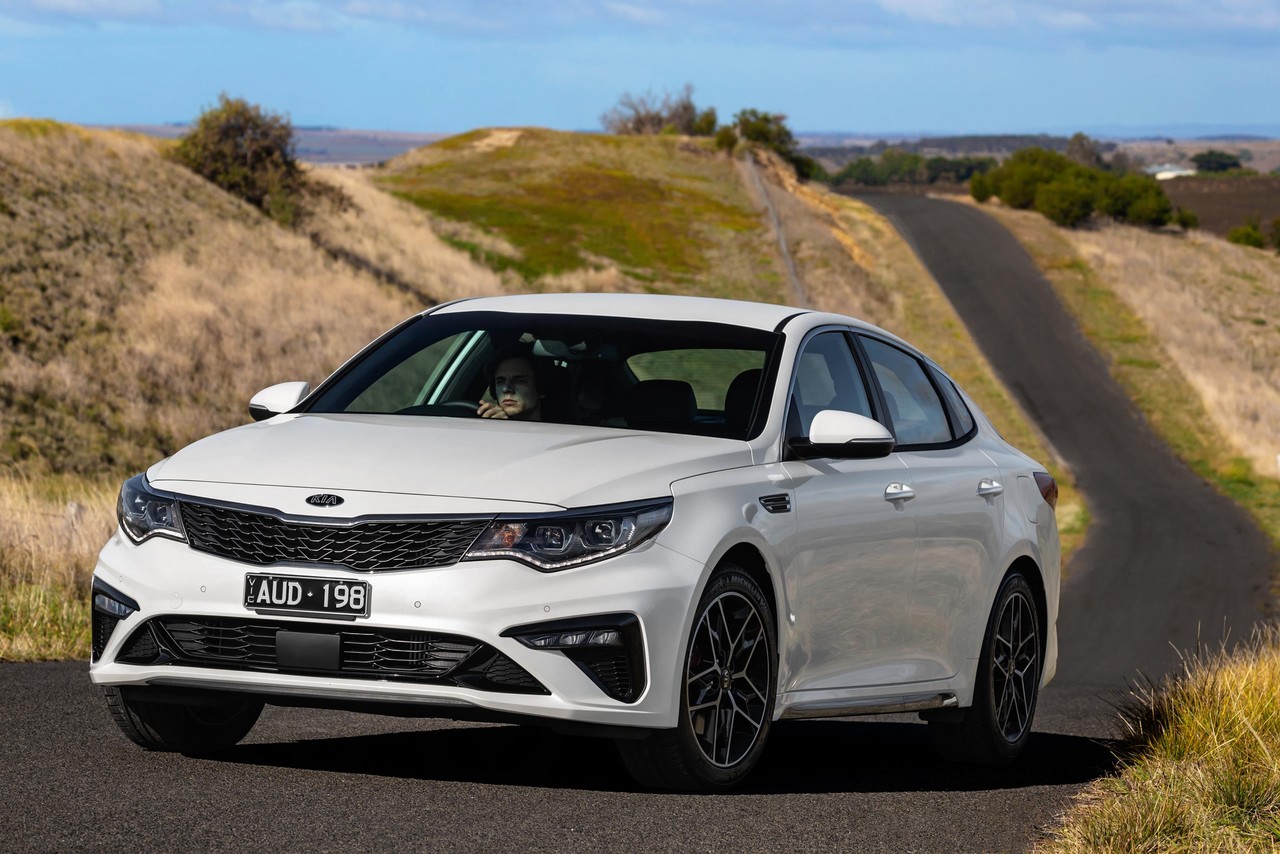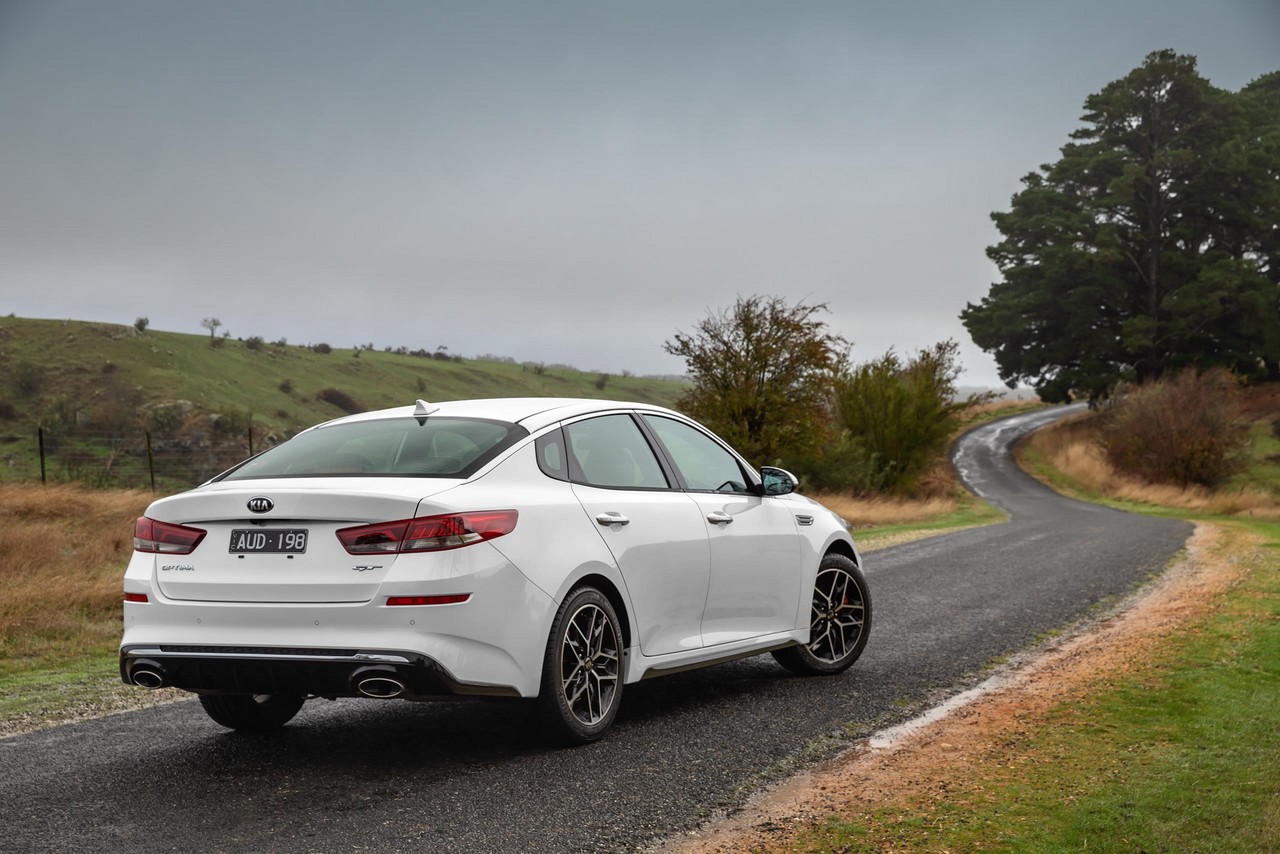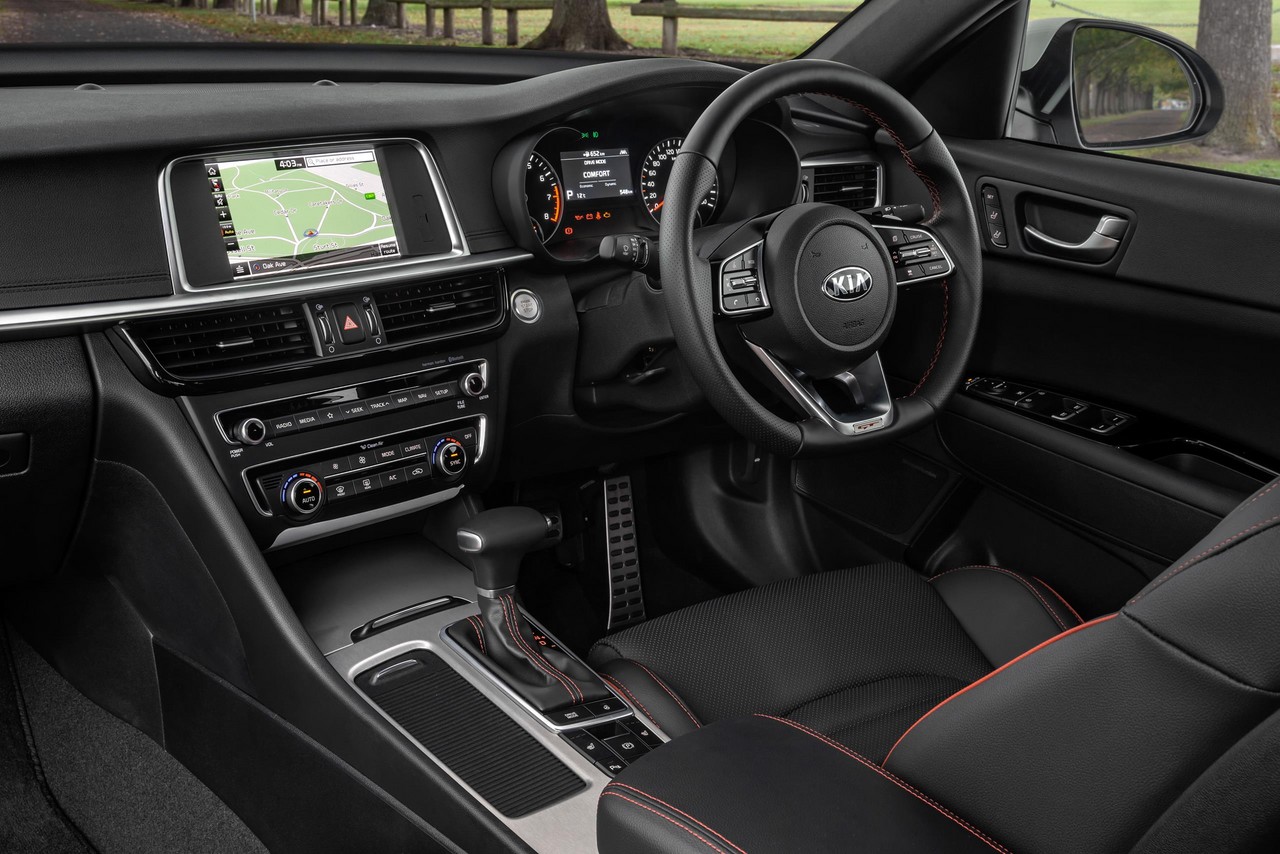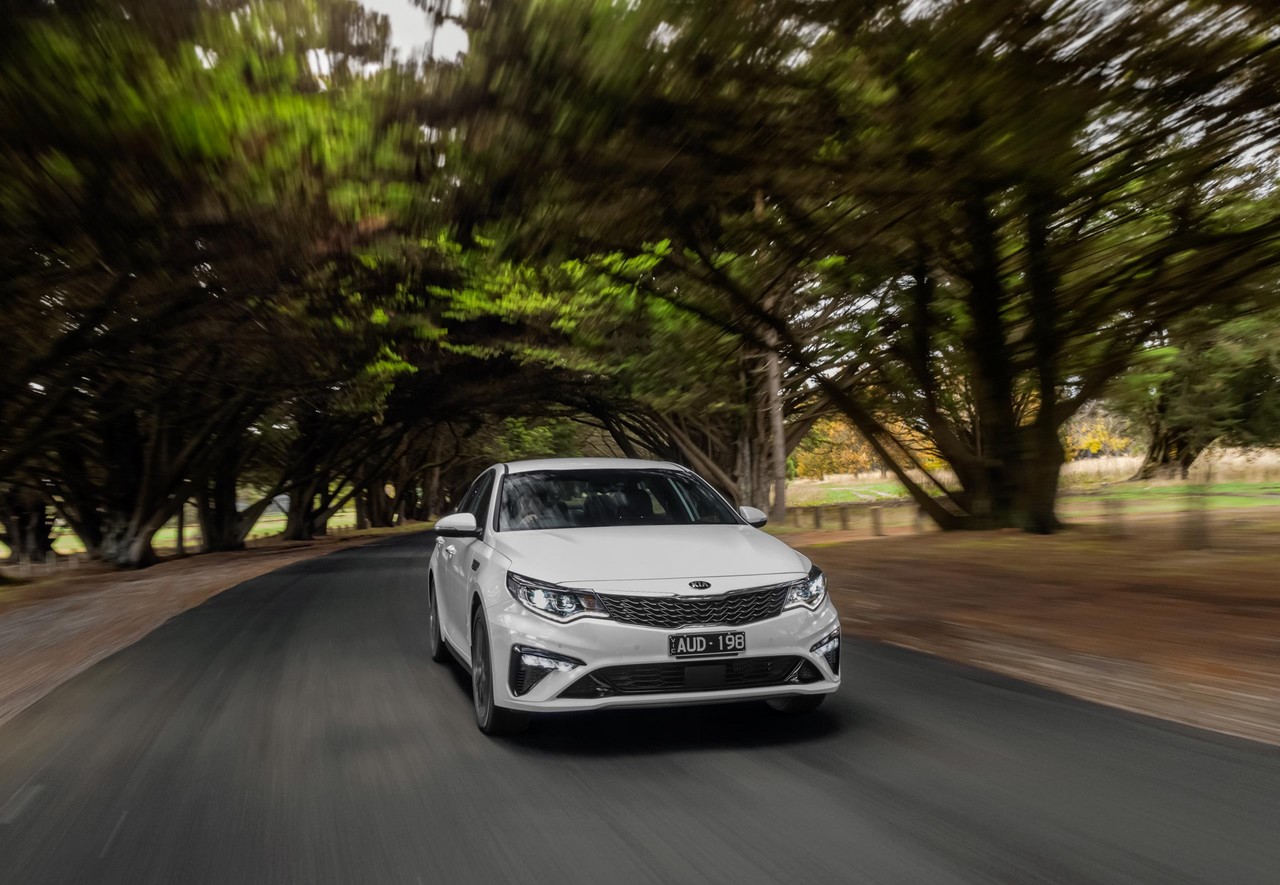
- Responsive 2.0-litre turbocharged petrol engine
- Impressive ride/handling balance
- For Optima GT, well-weighted steering provides good feedback
- Spacious interior with supportive front seats
- Quiet, well-insulated cabin
- 2.0-litre turbo engine not particularly economical and lacks refinement at higher rpm
- Price premium to related Hyundai LF Sonata
- Automatic transmission slow to respond to sequential shifts
- Awkward rear seat entry and exit
Review: Kia JF.I Optima (2015-18)
Overview
Released in Australia in November 2015, the Kia JF Optima was a mid-size sedan. Manufactured in Hwasung, South Korea, the front-wheel drive JF Optima was powered by 2.4-litre petrol and 2.0-litre turbocharged petrol engines for the Si and GT variants, respectively, while six-speed automatic transmissions were standard for both variants.
The Kia JF Optima was sold with a seven year warranty, capped price servicing and roadside assist.
Optima Si and GT ‘Theta II’ engines
For the Optima Si, the 2359 cc ‘Theta II’ naturally aspirated petrol engine had an aluminium block with 88.0 mm bores and a 97.0 mm stroke, an aluminium cylinder head, fracture-split sinter-forged connecting rods, direct fuel injection, hollow stainless-steel double overhead camshafts, four valves per cylinder, variable intake and exhaust valve timing, a two-stage variable induction system (VIS) and a compression ratio of 11.3:1.
For the Optima GT, the 1998 cc ‘Theta II’ turbocharged petrol engine differsed in that it has 86.0 mm bores and an 86.0 mm stroke, a twin-scroll turbocharger (understood to be a Mitsubishi TD04 turbocharger), an intercooler and its compression ratio was lowered to 10.0:1.
Over the combined ADR 81/02 test cycle, fuel consumption for the Optima Si and GT were 8.3 and 8.5 litres per 100 km, respectively.
| Engine | Trans. | Peak power | Peak torque | |
|---|---|---|---|---|
| Optima Si | 2359 cc petrol I4 (GDi) | 6sp auto | 138 kW at 6000 rpm | 241 Nm at 4000 rpm |
| Optima GT | 1998 cc turbo petrol I4 (T-GDi) | 6sp auto | 180 kW at 6000 rpm | 350 Nm at 1350-4000 rpm |
Body and dimensions
The Kia JF Optima shared its platform with the Hyundai LF Sonata and 50 per cent of its body consisted of Advanced High Strength Steel (AHSS) – a 150 per cent increase on the TF Optima – which contributed to a 50 per cent increase in torsional rigidity and an 8.6 kg lighter bodyshell. Other attributes included:
- A 450 per cent increase in the use of structural adhesive for greater structural rigidity and reduced noise, vibration and harshness (NVH); and,
- A 350 per increase in hot stamped components.
For the Optima GT’s panoramic sunroof, the bodyshell haD a support structure made from carbon-fibre reinforced plastic (CFRP).
For greater refinement, developments for the JF Optima included:
- A larger underbody cover which also reduced aerodynamic drag;
- Increased dashboard insulation;
- More effective windshield seals;
- Stiffer engine mounts, body panels and wheel bearings;
- Larger cross-member bushings to isolate road noise and reduce vibrations through the floor and steering wheel;
- 83 per cent stiffer alloy wheels; and,
- Stiffer seat frames and reshaped seats to reduce vibrations.
Compared to the Kia TF Optima , the JF Optima was 20 mm longer (at 4855 mm), 25 mm wider (1860 mm), 10 mm taller (1465 mm) and had a 10 mm longer wheelbase (2805 mm). Furthermore, the JF Optima had boot volume of 510 litres (VDA method) and a drag coefficient of 0.353 Cd (compared to 0.358 Cd for the TF Optima).
Suspension and steering
The Kia JF Optima hd MacPherson strut front and suspension and independent, multi-link rear suspension. Compared to the TF Optima,
- The suspension location points of the front and rear sub-frames were moved outwards for a more compliant ride over uneven surfaces;
- Four-bushing mounts were introduced for both sub-frames (previously dual bushing mounts); and,
- For the rear suspension, larger dual lower control arms were mounted on thicker, more absorbent bushings.
According to Kia, the Optima GT was fitted with ‘high performance dampers’ for ‘more immediate handling responses and a slightly firmer, sportier ride’.
The Kia Optima Si had a column-mounted, electric motor-driven power steering system (Kia’s ‘C-MDPS’). The Optima GT, however, had rack-mounted power steering system (‘R-MDPS’) for ‘greater steering feel and quicker, more linear responses to driver inputs’. Both models had a turning circle of 10.9 metres.
Safety equipment
Standard safety equipment for the Kia JF Optima included dual front airbags, front side airbags, full-length curtain airbags, ABS, electronic brake force distribution, brake assist, electronic stability control, traction control and front seatbelts with pretensioners and load limiters.
As standard, the Optima Si and GT were fitted with the following active safety technologies:
- Autonomous Emergency Braking (AEB): could detect a vehicle ahead and automatically apply the brakes to avoid or minimise the severity of a collision;
- Advanced Smart Cruise Control (ASCC): when cruise control was activate, ASCC could maintain a safe distance from the vehicle ahead by automatically braking and accelerating (up to the cruising speed);
- Lane Departure Warning System (LDWS): used a forward-facing camera to detect the car’s position its lane and alert the driver if they had departed from it without indicating; and,
- High Beam Assist (HBA): when the headlights were on, HBA would use high beam headlights when safe to do so and, if oncoming traffic was detected, would automatically revert to low beams.
The Kia Optima GT was further equipped with:
- Blind Spot Detection (BSD): could detect vehicles in the driver’s blind spot and provide a visual warning in the door mirror; and,
- Rear Cross Traffic Alert (RCTA): could detect approaching traffic that may cross the vehicle’s intended path when reversing out of a parking space.
Euro NCAP testing
In Euro NCAP testing , a left-hand drive 2015 Kia Optima that was powered by a 1.7-litre turbo-diesel engine received a five star safety rating that included an 89 per cent adult occupant protection rating and an 86 per cent child occupant protection rating. In the frontal offset test, protection of both front passengers was generally rated as good, though protection of the driver’s lower right leg was rated as adequate (i.e. a slight risk of serious injury). In the side impact and pole tests, maximum points were awarded.
Brakes
The Kia JF Optima had 320 mm by 28 mm ventilated front brake discs and 284 mm by 10 mm solid rear discs.
Features: Optima Si
Standard features for the Kia Optima Si included 7.5J x 17-inch alloy wheels with 215/55 R17 Continental ContiPremiumContact5 tyres, six speaker sound system with MP3 player, auxiliary inputs (3.5 mm/USB/iPod), Bluetooth mobile phone connectivity and audio streaming, satellite navigation with a seven-inch touchscreen, dual-zone climate control air conditioning, black cloth seat trim, six-way manually adjustable front seats with two-way power adjustable lumbar support, dual projector HID headlights with washers, LED daytime running lights, front and rear parking sensors, a rear view camera with parking guidelines, automatic headlights, rain-sensing wipers, a leather-wrapped steering wheel with gearshift paddles, 60:40 split and flat folding rear seats, remote central locking, power windows, power adjustable mirrors with automatic folding function, tilt and telescopic steering wheel adjustment, an electrochromic rear view mirror, two 12 volt power outlets, two USB charging ports, a trip computer and an immobiliser.
Unlike the Optima GT, the Optima Si was fitted with LED front fog lights and static cornering lights. Both the Optima Si and Optima GT, however, were fitted with a full size-spare tyre.
Features: Optima GT
Compared to the Optima Si, the Kia Optima GT was further equipped with 7.5J x 18-inch alloy wheels with 235/45 ZR18 Michelin Pilot Sport 3 tyres, a 590 watt Harman Kardon Premium Sound system with ten speakers, an external amplifier and ‘Clari-Fi’ MP3 restoration, eight-inch touchscreen, leather appointed seats, an eight-way power adjustable driver’s seat with four-way lumbar support, heated and ventilated front seats, directional bi-xenon headlights with Kia’s ‘Adaptive Front Lighting System’, a flat-bottom steering wheel with heating function, driver’s seat memory settings, power-operated panoramic sunroof, rear sunshade blinds, alloy scuff plates and pedals, aluminium interior trim and a colour ‘supervision’ instrument cluster.
The Optima GT was also fitted with a five watt wireless charger – located at the base of the central console – which activated when a compatible device was placed on the pad. Furthermore, the Optima GT had a ‘smart trunk’ that would automatically open when the key was detected in close proximity.
The Optima GT could be identified by its more aggressive front bumper, black high gloss side sills, red-painted brake calipers, subtle rear air diffuser with integrated dual tailpipes, LED tail-lights and ‘GT’ badging. For Optima GT models with Snow White Pearl, Aurora Black and Platinum Graphite paint finishes, buyers could specify red leather interior trim with grey stitching.
Specifications
Related links
- Kia Media: All-New 2016 Optima Midsize Sedan Makes Global Debut
- Kia Media: 2016 Kia Optima to Debut at New York Auto Show
- Wikipedia.org: Kia Optima
- Behind the Wheel: 2017 Kia Optima Si Review
- AustralianCar.Reviews: Hyundai LF Sonata Review
Review: Kia JF.II Optima (2018-19)
Overview
The Kia JF Series II (JF.II) Optima was released in Australia in June 2018. Visually, the JF.II Optima could be identified by its new grille and front fascia, upper and lower rear panels, and alloy wheel designs. Inside, the JF.II Optima had a new infotainment head unit that had a seven-inch display for the Optima Si and an eight-inch display for the Optima GT. The infotainment system also featured Apple CarPlay and Android Auto smartphone integration.
According to Kia Australia, the JF.II Optima provided greater ‘ride refinement’ and steering feel than its predecessor.
| Engine | Trans. | Peak power | Peak torque | |
|---|---|---|---|---|
| Optima Si | 2359 cc petrol I4 (GDi) | 6sp auto | 138 kW at 6000 rpm | 241 Nm at 4000 rpm |
| Optima GT | 1998 cc turbo petrol I4 (T-GDi) | 6sp auto | 180 kW at 6000 rpm | 350 Nm at 1350-4000 rpm |
Safety equipment
For the Kia JF.II Optima, standard safety equipment was extended to include Driver Attention Alert (DAA) which monitored driver behaviour and provided visual and audible warnings if signs of fatigue were detected. Furthermore, the Lane Departure Warning System (LDWS) was replaced by Lane Keeping Assist (LKA) which monitored the vehicle’s position within its lane and provided an audible alerts and steering inputs to maintain the vehicle’s position.
Features: Kia JF.II Optima
As noted above, the new infotainment unit for the Kia JF.II Optima featured Apple CarPlay and Android Auto smartphone integration. Compared to their JF.I predecessors, however,
- The Kia JF.II Optima Si was no longer fitted with satellite navigation or HID headlamps (the latter replace by dual projection headlamps);
- The Kia JF.II Optima GT was no longer fitted with a power adjustable front passenger seat (replaced by manual adjustment) and the ventilated front seats were replaced by heated front seats. A panoramic sunroof and tyre pressure monitoring were also omitted.
For a complete list of features, please refer to the specifications document below.
Specifications
Related links
